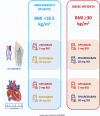Direct-Acting Oral Anticoagulants in patients at extremes of body weight: a review of pharmacological considerations and clinical implications
- PMID: 38197017
- PMCID: PMC10774013
- DOI: 10.1055/s-0043-1776989
Direct-Acting Oral Anticoagulants in patients at extremes of body weight: a review of pharmacological considerations and clinical implications
Abstract
Patients at extremes of body weight are underrepresented in randomized controlled trials of direct-acting oral anticoagulants (DOACs). Therefore, their optimal anticoagulant treatment remains a topic of debate. The aim of this narrative review is to summarize the evidence on the pharmacokinetic and pharmacodynamic profile of DOACs for treating patients at extremes of body weight in venous thromboembolism (VTE) and in the prevention of cardioembolic stroke in nonvalvular atrial fibrillation (NVAF). A literature search was conducted in the main bibliographic databases, and the most relevant reviews and original articles on the topic were selected. Although data in these patient groups are limited, apixaban and rivaroxaban show a favorable pharmacokinetic and pharmacodynamic profile in obese VTE treatment and NVAF patients and, in the case of apixaban, also in underweight patients. In particular, these drugs demonstrated comparable efficacy and safety to standard therapy. Very few data were available for dabigatran and edoxaban; the latter drug was safer at a lower dose, mainly in underweight patients. Our findings are in line with the last International Society of Haemostasis and Thrombosis position paper and European Heart Rhythm Association 2021 practical guide, suggesting the use of apixaban and rivaroxaban in morbidly obese patients (>120 kg or body mass index ≥40 kg/m 2 ) and the reduced dosage of edoxaban in low-weight patients. Future studies should focus on large populations of patients at extremes of body weights to acquire more clinical and pharmacokinetic evidence on all available DOACs, especially those currently less investigated.
Keywords: direct-acting oral anticoagulants; extremes of body weight; obese; pharmacokinetics; underweight.
The Author(s). This is an open access article published by Thieme under the terms of the Creative Commons Attribution License, permitting unrestricted use, distribution, and reproduction so long as the original work is properly cited. ( https://creativecommons.org/licenses/by/4.0/ ).
Conflict of interest statement
Conflict of Interest R. Talerico and R. Pola have no conflicts of interest to declare. F.A. Klok has received research support from Bayer, Bristol-Myers Squibb, Actelion, Boston Scientific, Leo Pharma, The Netherlands Organisation for Health Research and Development, The Dutch Thrombosis Association, The Dutch Heart Foundation and the Horizon Europe program, all outside this work and paid to his institution. M.V. Huisman has received research support from Dutch Heart Foundation, Dutch Healthcare Fund, Boehringer Ingelheim, Bayer Health Care and Leo Pharma, all outside this work.
Figures
References
-
- Stevens S M, Woller S C, Kreuziger L B et al.Antithrombotic therapy for VTE disease: second update of the CHEST guideline and expert panel report. Chest. 2021;160(06):e545–e608. - PubMed
-
- ESC Scientific Document Group . Konstantinides S V, Meyer G, Becattini C et al.2019 ESC Guidelines for the diagnosis and management of acute pulmonary embolism developed in collaboration with the European Respiratory Society (ERS) Eur Heart J. 2020;41(04):543–603. - PubMed
-
- ESC Scientific Document Group . Hindricks G, Potpara T, Dagres N et al.2020 ESC Guidelines for the diagnosis and management of atrial fibrillation developed in collaboration with the European Association for Cardio-Thoracic Surgery (EACTS): The Task Force for the diagnosis and management of atrial fibrillation of the European Society of Cardiology (ESC) Developed with the special contribution of the European Heart Rhythm Association (EHRA) of the ESC. Eur Heart J. 2021;42(05):373–498. - PubMed
-
- January C T, Wann L S, Calkins H et al.2019 AHA/ACC/HRS Focused Update of the 2014 AHA/ACC/HRS Guideline for the Management of Patients with Atrial Fibrillation: a report of the American College of Cardiology/American Heart Association Task Force on Clinical Practice Guidelines and the Heart Rhythm Society. J Am Coll Cardiol. 2019;74(01):104–132. - PubMed
Publication types
LinkOut - more resources
Full Text Sources


